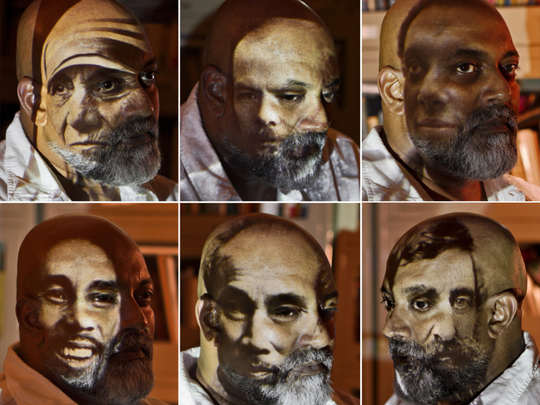
Vivek Vilasini lived and worked in Dubai during the 1990s and became part of one of the most important artists’ communities of the time that included the late Hassan Sharif and other pioneering Emirati artists. He participated in major group shows with these artists until he moved back to India in 1999. In Dubai he was known for his large sculptures and installations, but now he is a well-known photographic artist whose work has been exhibited around the world.
Almost two decades after leaving the UAE, the Indian artist has returned to present his first solo show in Dubai, Between One Shore and Several Others. The show features a retrospective of his career as a photographic artist along with new works, including sculptural installations. The entire body of work explores the transmigration of concepts, their assimilation, internalisation and the evolution of identities.
“I am interested in the transmigration of ideas and symbols and what they become when they are dislocated from their origins. The evolution of our identity is an ongoing process embedded in everyday social practices. The ideas that shape our identity usually come from our own environment such as local places, customs and histories. But in today’s world people are exposed to ideas from other places and cultures offering alternatives that allow them to escape the circumstances of their origin. I want to see how people access and internalise these ideas, make them their own, and incorporate them in their identity by adapting and expanding the original concepts in a new context. This is the perspective from which I look at everything and the main concept behind all my work,” Vilasini says.
“Long ago I came across the title ‘Between one shore and several others’ in a book written by an Emirati writer, and it stayed with me because it could apply to people, ideas, histories and cultures moving from one shore to other shores. It has become a recurrent title of my artworks and my shows,” he adds.
The first series he created with this title is a set of photographs of people from the southern Indian state of Kerala, who are all named after well-known communist leaders and thinkers, such as Lenin, Stalin, Ho Chi Minh, Che Guevera, Marx and Gramsci. It also includes a portrait of a woman named Soviet Breeze. “These foreign names are extremely common in Kerala. I find it interesting how these ordinary people from India and their parents have tried to construct their identity based on certain ideologies. The names reflect the waves of communism that came to Indian shores at different times and how we connected with them and assimilated them in our own peculiar way,” the artist says.
In another series, Ways of Seeing, the artist projected on his face images of people who have influenced him to create composite portraits suggesting that he sees the world through their eyes. His heroes include writers, poets, thinkers, leaders and activists such as Allen Ginsberg, Pablo Neruda, Bob Marley, Dostoyevsky, Ho Chi Minh, Mother Teresa, Gandhi and Stokely Carmichael, founder of the Black Panther Party. “The title of this series refers to the award-winning television series by John Berger from the 1970s, and the images allude to the Indian philosophical concept of seeing through the third eye,” the artist says.
Another work by the artist that blends two different shores is Recruiting Station from 2013. It features a group of barefoot, malnourished-looking young Indian men assembled to form the figure of a horse, transposed in front of a US armed forces recruiting station in New York’s Times Square. The image evokes conflicts and power struggles around the world and speaks about the inequality and racism in modern society and the widening gap between the rich and poor that leads to impoverished people being sucked up in proxy wars.
The horse is a reference to a common motif in Indian miniature paintings but it is also a reminder of the Trojan horse used by an ancient army to smuggle soldiers into enemy territory, referencing the hidden interference of foreign powers in socio-political conflicts in the region, and the resulting influx of migrants on their shores. “The three elements in this image — the American recruiting station and what it means to the world, the hopeful recruits forming a horse, and the Zebra crossing on which they are standing create layers of meaning allowing for various possible interpretations,” Vilasini says.
While this image is carefully staged, a lot of Vilasini’s work simply highlights quirky things he observes in his surroundings. In a series titled Housing Dreams, he has put together a group of photographs of rural homes that have been used as billboards by large companies. The images humorously highlight the incongruity and absurdity of the dreams of fashionable clothes, fancy cars and other consumer goods being sold to simple farmers.
The photographs include an advertisement for roofing solutions ironically painted on a hut without a roof; an entire settlement on a hill painted with the bright yellow colour and logo of a company; and an advertisement for lingerie displayed on a farmhouse surrounded by fields, cows and an old woman drawing water from a well. The artist’s keen sense of observation and subtle humour are also evident in an image featuring an advertisement for a German product on a wall juxtaposed with a tiny Indian swastika symbol painted on the door by the occupants to mark a festival.
Other works feature photographs of huge billboards looking out of place in rural settings, and a wall covered with photographs of walls of homes painted in the most garish colours titled, Housing Dreams Walls. “Keralites like to paint their walls with bright colours. These days walls have become a politically loaded topic. I want to add my colourful walls to the conversation,” Vilasini says with a smile.
In stark contrast with these bright pictures is a hazy, grey picture of a train pulling out of Bhatinda station in the north Indian state of Punjab at dawn. The work titled Too Many fables on the Rails. The Cancer Express, speaks about the damage human beings have done to the planet and its repercussions on us.
“After India became independent the enterprising and hardworking people of Punjab successfully brought about a green revolution making it one of the most prosperous states in the country. But due to the excessive use of fertilisers and pesticides at that time, today the ground water has been severely contaminated and there is a very high incidence of cancer in the state. Many cancer patients from Punjab travel to Bikaner in Rajasthan for treatment at a charitable hospital in this train, which is free for patients. When I read about the train, which locals call ‘the Cancer Express’ I wanted to photograph it because it is a symbol of the problems we have created for ourselves due to our ignorance, greed, flawed idea of progress, bad planning and inability to live in harmony with nature as well as of the problems we will face in the future,” Vilasini says.
The artist has gone back to sculpture in a series of works featuring copper plates embossed with the symbols and names of various political parties in India. The work explores how the parties and their supporters in a vibrant democracy like India project their ideology and construct their identity through symbols such as a bucket, a drum, a lamp, an arrow or a sun without rays. “I am also interested in seeing how these hand-beaten works that look like primitive relics are read in places with different political systems and ideologies as they travel from one shore to several others,” Vilasini says.
Jyoti Kalsi is an arts-enthusiast based in Dubai.
Between One Shore and Several Others will run at 1x1 Gallery, Alserkal Avenue, Al Quoz, until April 30.












